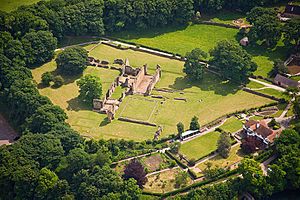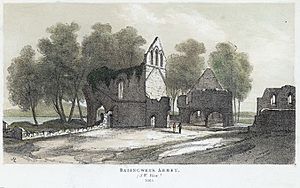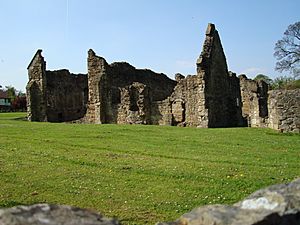Basingwerk Abbey facts for kids
Quick facts for kids Basingwerk Abbey |
|
|---|---|
|
Abaty Dinas Basing
|
|

Remains of Basingwerk Abbey
|
|
| Religion | |
| Affiliation | Catholicism, Cistercians |
| Ecclesiastical or organizational status | ruins |
| Year consecrated | 1132 |
| Location | |
| Location | Holywell, Flintshire, Wales |
| Architecture | |
| Architectural type | Monastery |
| Architectural style | Cistercian |
Basingwerk Abbey (Welsh: Abaty Dinas Basing) is a very old ruined abbey in Wales. It's located near Holywell, in Flintshire. This special building was founded in the 1100s. It belonged to a group of monks called the Cistercians. These monks owned a lot of land, even far away in Derbyshire, England.
The abbey was closed down in 1536. This happened during a time called the Dissolution of the Monasteries. Today, the Welsh heritage agency, Cadw, looks after the ruins. It is a Grade I listed building, which means it's very important.
Contents
When was Basingwerk Abbey built?
Basingwerk Abbey was started in 1132. It was founded by a powerful person named Ranulf de Gernon, 4th Earl of Chester. He first brought Benedictine monks from a place called Savigny Abbey in France.
Later, in 1147, the abbey became part of the Cistercian Order. This order was a big part of the Catholic faith. Basingwerk was linked to another abbey, Buildwas Abbey, in England.
How did the abbey get its land?
The abbey received many gifts of land. King Henry II gave the monks a manor near Glossop in England. This land was quite far from the abbey itself. The monks worked hard to manage their properties. You can still find names like "Monks' Road" and "Abbot's Chair" near Glossop. These names remind us of the abbey's history there.
In 1290, the abbey was allowed to hold a market in Glossop. This helped the monks earn money. They also got permission for a market in Charlesworth in 1328.
What was the abbey's role in Welsh history?
In the 13th century, a famous Welsh prince, Llywelyn the Great, supported the abbey. His son, Dafydd ap Llywelyn, later gave the monks control of St Winefride's Well. This well was a very important holy site.
The monks were clever! They used the water from the Holywell stream. They built a corn mill to grind grain. They also used the water to clean wool from their sheep.
What happened to the abbey?
In 1536, life at Basingwerk Abbey came to an end. This was because of the Dissolution of the Monasteries. This event happened when King Henry VIII closed down many monasteries in England and Wales. The abbey's lands and buildings were then sold to other people.
There's an old legend about a monk from Basingwerk Abbey. It says he was drawn into a nearby wood by a nightingale's song. He thought he only listened for a short time. But when he came back, the abbey was in ruins! He then turned to dust himself.
Interestingly, parts of the abbey's roof were moved. A Welsh seer, Robin Ddu, had predicted this. Some roof parts went to St Mary's Church in Cilcain. Another part of the roof is said to be at St Peter's Church in Ruthin. Even a special window from the abbey, called a Jesse window, went to a church in Llanrhaeadr-yng-Nghinmeirch.
What can you see at Basingwerk Abbey today?
Today, the ruins of Basingwerk Abbey are part of the Greenfield Valley Heritage Park. Cadw, the Welsh heritage agency, takes care of them.
The abbey is also the starting point for the North Wales Pilgrims Way. This is a long walking route for people who want to explore historical and religious sites.
Images for kids
See also
 In Spanish: Abadía de Basingwerk para niños
In Spanish: Abadía de Basingwerk para niños








